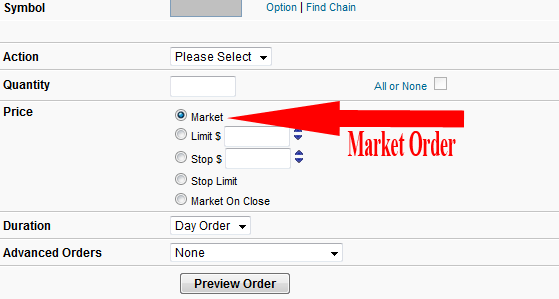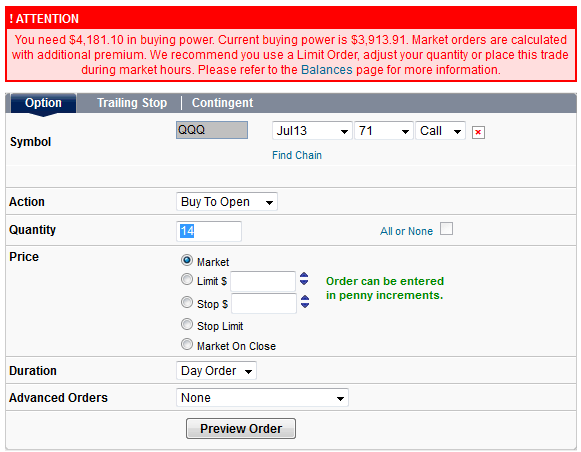What Does Market Order Do in Options Trading?
Market Order - Definition
Market order is an order to buy or sell your options positions at a price that gets an immediate, or as quick as possible, fill.
What Is Market Order?
Market Order is one of two main forms of filling orders used in options trading. The other main form of filling order is the "Limit Order". A market order is an order that orders your options broker to sell or buy your options position at any price in the market that gets an immediate fill. This is in contrast to the "Limit Order" that instructs your broker to only buy or sell your options position at the "Limit Price" stated by you, or at a better price than stated, or the "Even Order" that instructs your broker to fill an options spread at no cash paid or received.
That's right, in order to get an immediate fill, market orders will grab the best existing offer in the market in order to fill the position immediately. That can actually, and often do, result in a lousier price than expected.
How To Place A Market Order?
When you fill out the "Order Form" in your options broker account for either buying or selling single options or options spreads, there will always be a section titled "Price" or "Fill" or "Filling Order". This is where you choose the kind of filling order you want for your trade. You simply click on or choose "Market" or "Market Price" or "Market Order", depending on the specific term used by your options broker. This tells your options broker that you wish for your position to be filled as quickly as possible using the best currently available market price.

How Does Market Orders Work?
So, what actually happens when you place a Market Order? When you submit your order form or trading form indicating "Market" order, your order immediately goes to your options broker who will seek the best price in the market for immediately filling the order. This "best price" is really the bid and ask offers by market makers currently asking for that option in the market. Your options broker will then take the best price and fulfill the trade regardless of what that "best price" may be. As such, this "best price" can actually be much higher or lower than the bid ask price or last price you see on your options chain. By sending a market order, you are in effect telling your options broker "Hey, I just want this trade filled right away no matter what the price may be".
Problem with Market Orders
The main problem with using market orders is that you are really leaving your options broker and the market to decide what price to sell you your options for or what price to buy your options from you for. You are giving away control of the price for the sake of being able to immediately gain possession of the options contracts or to immediately dispose of your options contracts. In the case of selling away your options position, you are in effect saying "Take my options away at whatever price you are asking for... I just want to get rid of it". This isn't a big problem for options contracts that are highly liquid (learn more about Options Liquidity), such as QQQ or AAPL options, as there is always enough market makers vying for these options contracts in the market to make sure that you will always get filled at or very close to the bid ask price that you see in your options chain when placing the order. The problem with market orders comes with illiquid options contracts that have very little market makers interested in them. Its like trying to sell something in a market nobody wants and in the end when someone comes along to pick it up from you, the price will always be very lousy. Vice versa, if you try to buy an illiquid options contract using market order, you might get filled at a significantly higher price than you see on the options chain due to market makers deliberately selling to you at an extremely inflated price. As such, market orders should be used with caution and only when trading highly liquid options contracts.
Example of Market Order FillingAssuming options of XYZ company is highly illiquid and its call options at $50 strike price is quoted with bid price of $1.80 and ask price of $4.50. Assuming you decide to buy XYZ's $50 strike price call options using market order seeing that its ask price is $4.50. However, the moment the trade is placed and filled, you see that it was actually filled at $5.00 instead of the $4.50 ask price. |
When To Use Market Orders
Since market order is really a "panic button" to get your options order or options trade immediately filled, it can be extremely useful when trading highly liquid options in strong moving markets. When you are trading a highly liquid option, such as options on QQQ or AAPL, and prices are moving very quickly due to a strong market, you will very often miss the whole trade if you try to trade using "Limit Order". Missing a Sell To Close order order can mean selling later at a much lower price and missing Buy To Open order can mean buying later at a higher price when in a strong moving market. In this case, using market order will allow you to get filled at the best market price very quickly with very little slippage and not risk missing the entire trade altogether due to your limit price not being reached at all.
Example of Using Market Order in Fast Moving MarketAssuming AAPL's May $425 strike price call options are asking at $20.00 and the stock price of AAPL is rallying strongly. In order to fill the order as quickly as possible in order to get in on the rally quickly, you decided that AAPL's May $425 strike price call options are liquid enough to use market order safely and you buy to open 10 contracts using market order. The moment the order is filled, you see that it has been filled at $20.10, which is very close to the $20.00 you saw a moment ago. The slightly higher price is most likely due to the price of AAPL actually rising during the course of filling out the market order and submitting it rather than a liquidity issue. |
Options Trades That Can Only Be Done Using Market Orders
Even though the choice of using market order or limit order is largely up to the individual options trader, there are actually some options orders and trades that can only be done using Market Order and not limit order. Basically, all advanced automatic orders that automatically sell for stop loss / profit taking or buy your options positions when certain predetermined criteria are met can only be done using Market Order as your broker requires the liberty to trade your position the moment the criteria are met at the prevailing market price. Such orders include Contingent Orders, Trailing Stop Loss orders and Market Stop order.
Additional Premium Required When Using Market Orders
Due to the fact that the actual filling price might be higher or lower than the bid ask price last indicated in the options chains, all options brokers require additional cash to be available in your account in order to place market orders. This means that if you are trying to buy 14 contracts of an option asking $1.00 with exactly $1400 cash in your options account, you will not be able to do so and your options broker will advise you to deposit more money or reduce the number of contracts that you are buying. In fact, additional premium for placing market orders can be as high as twice the value of the options or more, depending on your options broker's policies. Below is an example of one such alert.

Advantages of Market Order
1. Quick order filling particularly important in fast moving markets
Disadvantages of Market Order
1. Risk of bad prices when trading illiquid options contracts
2. Requires additional premium in account

|
Can't Decide Which Options Strategy To Use? Try our Option Strategy Selector! |
| Javascript Tree Menu |
Important Disclaimer : Options involve risk and are not suitable for all investors. Data and information is provided for informational purposes only, and is not intended for trading purposes. Neither www.optiontradingpedia.com, mastersoequity.com nor any of its data or content providers shall be liable for any errors, omissions, or delays in the content, or for any actions taken in reliance thereon. Data is deemed accurate but is not warranted or guaranteed. optiontradinpedia.com and mastersoequity.com are not a registered broker-dealer and does not endorse or recommend the services of any brokerage company. The brokerage company you select is solely responsible for its services to you. By accessing, viewing, or using this site in any way, you agree to be bound by the above conditions and disclaimers found on this site.
Copyright Warning : All contents and information presented here in www.optiontradingpedia.com are property of www.Optiontradingpedia.com and are not to be copied, redistributed or downloaded in any ways unless in accordance with our quoting policy. We have a comprehensive system to detect plagiarism and will take legal action against any individuals, websites or companies involved. We Take Our Copyright VERY Seriously!
Site Authored by